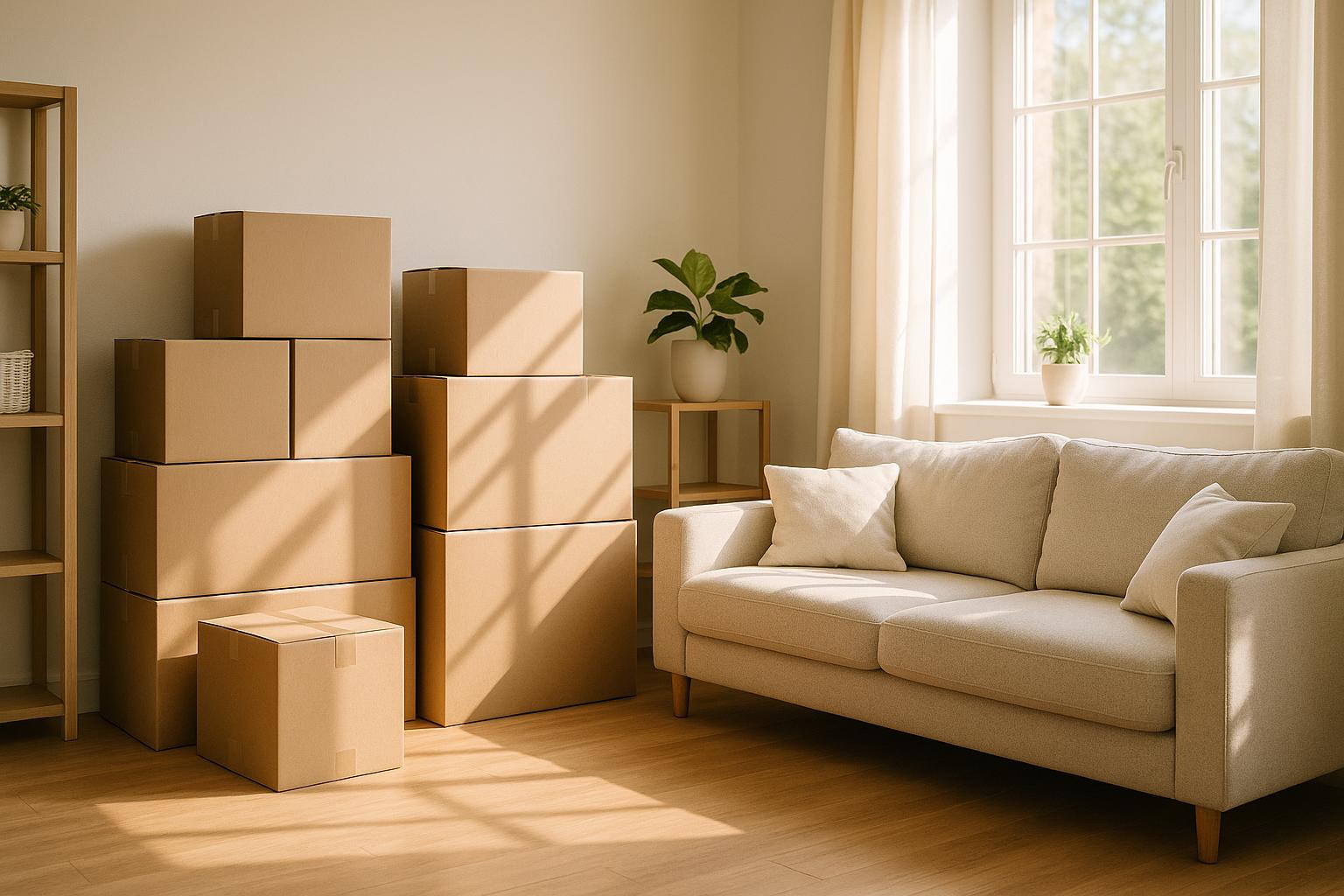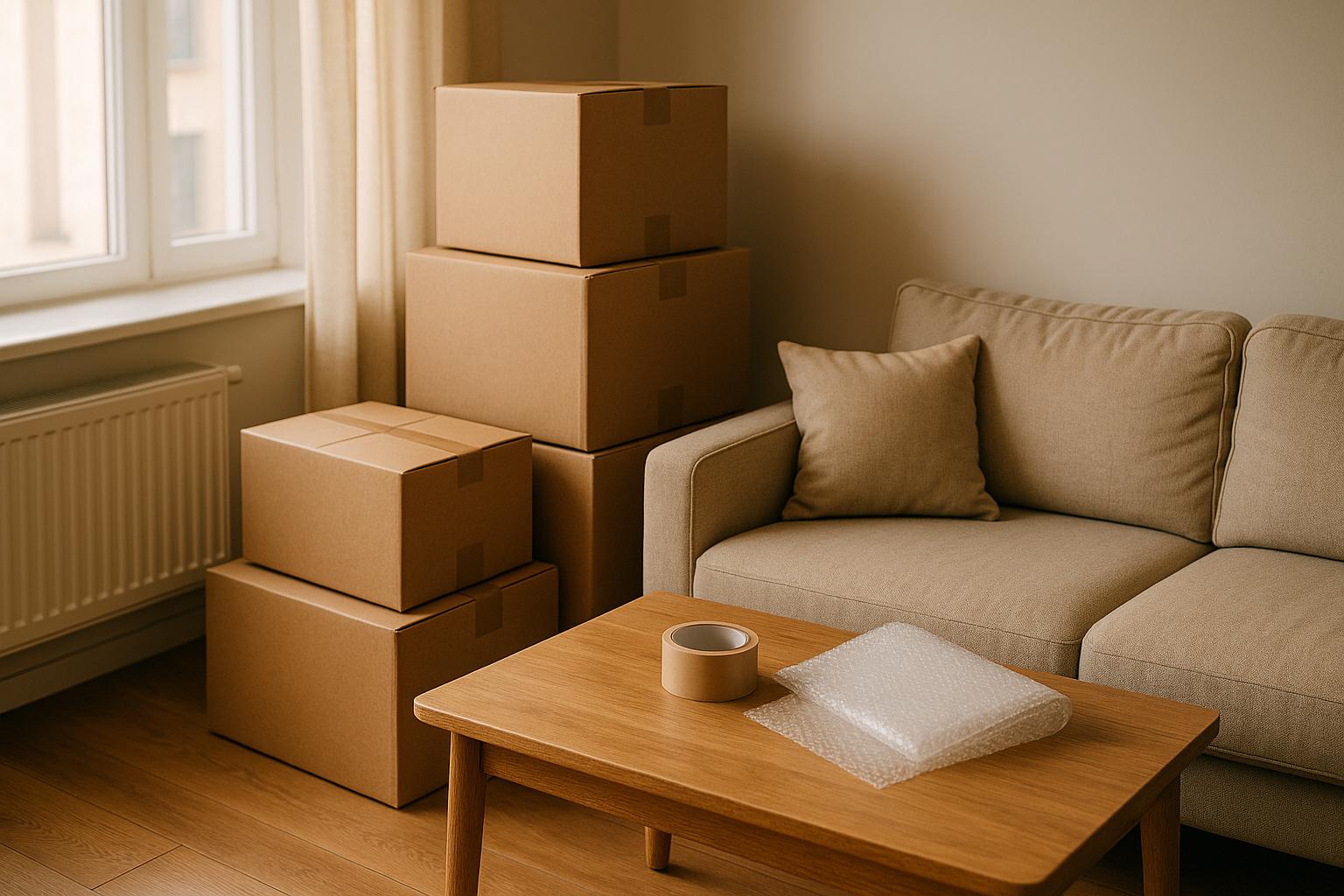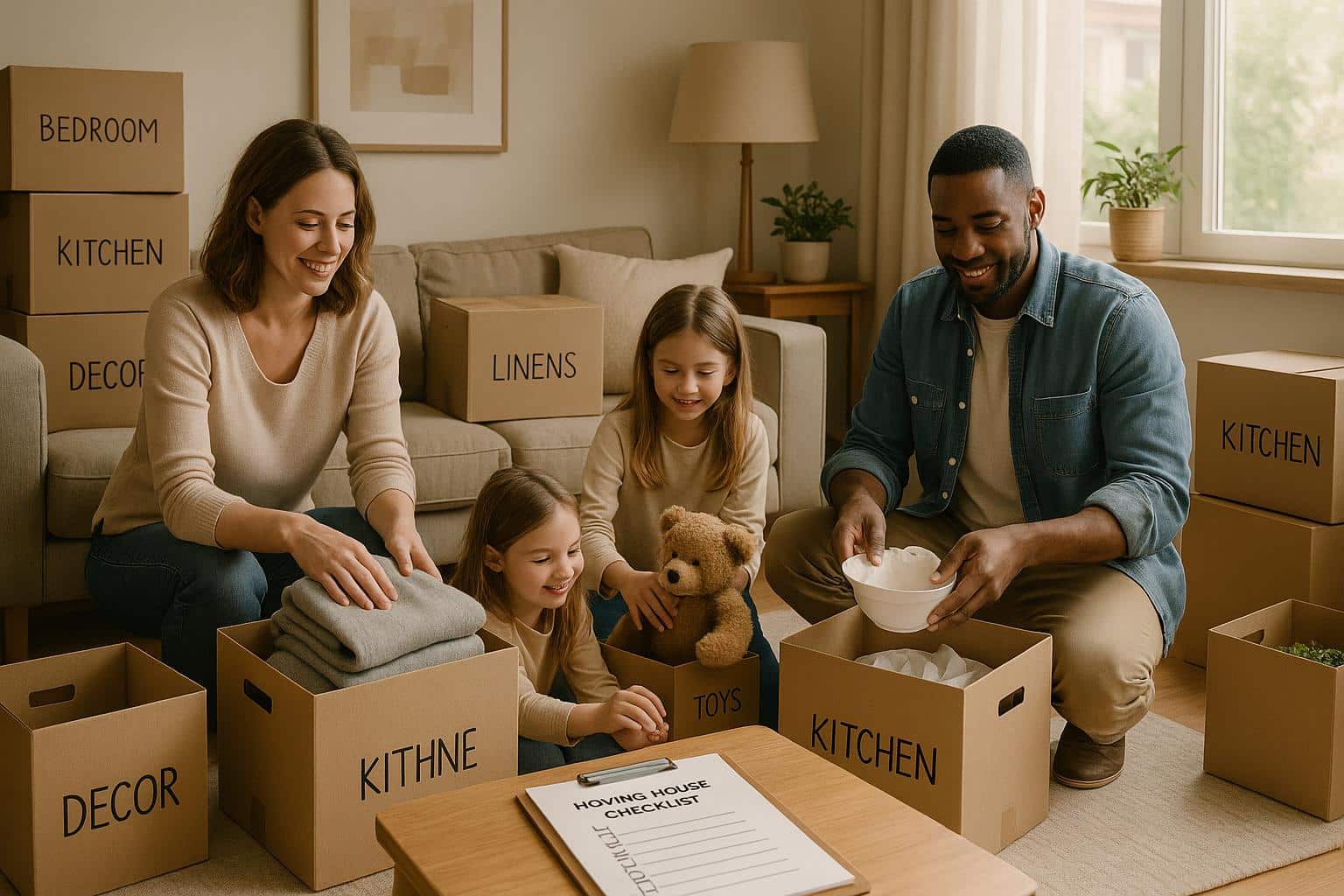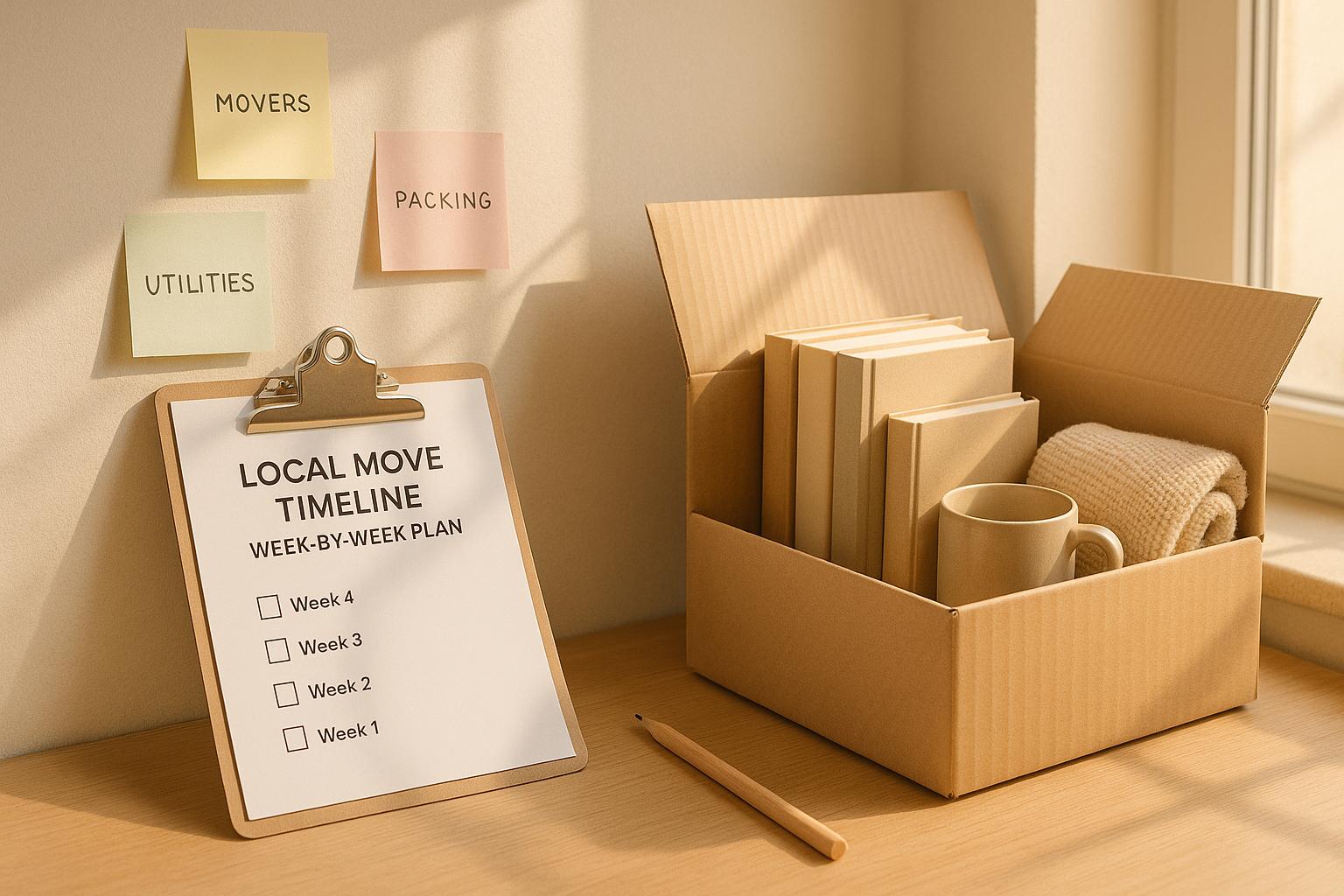Moving fragile items can be stressful, but with the right approach, you can keep your delicate belongings safe. Here’s what you need to know:
- Use strong materials: Double-walled boxes, bubble wrap, packing paper, and packing peanuts are essential.
- Wrap each item individually: Prevent scratches and breakage by wrapping glassware, dishes, and electronics carefully.
- Pack tightly: Fill empty spaces in boxes to avoid movement during transit.
- Label clearly: Mark boxes with "FRAGILE" and "THIS WAY UP" for careful handling.
- Organise and secure: Stack heavier boxes at the bottom, use tape to reinforce boxes, and secure items in the van with straps or blankets.
- Consider professional help: For high-value or temperature-sensitive items, professional movers can provide tailored care.
How to Pack for a Move-Fragile Items
Packing Materials and Tools You Need
Using the right supplies can make all the difference in ensuring your fragile items reach their destination safely. Let’s take a closer look at the essential packing materials and how their quality plays a role in protecting your belongings.
Essential Packing Supplies for Fragile Items
Sturdy boxes are the backbone of safe packing. For added protection, opt for double-walled boxes – they’re stronger and less likely to collapse under pressure. Smaller boxes are ideal for heavy or delicate items as they minimise movement during transit.
If you still have the original packaging for electronics or appliances, use it. These boxes are designed specifically to protect the items they came with. If not, specialised containers for items like picture frames or mirrors can be a great alternative.
Bubble wrap is a must for cushioning. Large bubbles are excellent for absorbing heavy impacts, while smaller ones help prevent scratches. For the best results, wrap items with the bubble-side facing inward. Bubble wrap pouches are also handy for protecting smaller items like mugs.
Packing paper is great for wrapping fragile items to prevent scratches and for filling empty spaces in boxes to reduce movement. Many packing papers use recycled newsprint, making them an eco-friendly choice.
Packing peanuts are perfect for filling gaps around irregularly shaped items. For an environmentally friendly option, biodegradable peanuts are widely available.
Choosing High-Quality Packing Materials
When it comes to fragile items, quality matters. Double-walled boxes are sturdier than single-walled ones, offering better protection. High-quality bubble wrap and packing paper provide more effective cushioning, while properly sized boxes reduce unnecessary movement. Investing in durable materials ensures your items stay safe, even during a bumpy journey.
How to Pack Different Types of Fragile Items
Packing fragile items isn’t a one-size-fits-all task. Each item comes with its own set of challenges, so adopting the right techniques is key to keeping your belongings intact. Here’s how to handle some of the most delicate items.
Packing Glassware and Dishes
Start by lining the bottom of your box with a 5–8cm cushion of crumpled packing paper or bubble wrap. This creates a shock-absorbing layer to protect your items from bumps during transport.
Wrap each piece individually to prevent them from touching. For plates and bowls, place each item in the centre of a sheet of clean, ink-free packing paper (avoid newspaper as the ink can stain), and fold the paper over until the item is fully covered. Pack plates vertically, like vinyl records, as this reduces the risk of cracking. Add a layer of packing paper or bubble wrap between each plate for extra safety.
When it comes to glassware, wrap the outside of each piece with packing paper and stuff crumpled paper inside to provide internal support. For stemware like wine glasses, wrap the stem separately with bubble wrap before wrapping the entire glass. Some people even use materials like coffee filters or pipe cleaners to give delicate stems extra protection. Always pack glasses upright and fill any gaps in the box with crumpled paper to limit movement.
Packing Electronics Safely
Electronics are particularly sensitive, so careful handling is crucial. Whenever possible, use the original packaging, as it’s designed to offer the best protection. If that’s not an option, select a sturdy box that closely fits the item.
Wrap screens in bubble wrap, with the bubbles facing inward to prevent scratches. For laptops and tablets, close the device and wrap it thoroughly, paying extra attention to corners and ports. For high-value electronics, consider double-boxing: wrap the item in cushioning, place it in a smaller box, and then nest that box inside a larger, padded one.
Always transport electronics upright to avoid damaging internal components or screens. Clearly label the box with phrases like "THIS SIDE UP" and "FRAGILE – ELECTRONICS." Don’t forget to remove batteries from devices to prevent leaks, and pack cables and accessories separately in labelled bags to make reassembly easier.
Packing Mirrors and Picture Frames
Mirrors and frames need special care due to their size and fragile glass surfaces. Protect corners by taping small pieces of cardboard over them to guard against chips.
If you have access to specialised mirror boxes, use them. If not, you can improvise by securing cardboard sheets on both sides of the mirror or frame. To add extra protection, apply masking tape in an "X" pattern across the glass. While this won’t stop the glass from breaking, it helps keep shards together if a crack occurs, making cleanup safer.
Always transport mirrors and frames upright to distribute their weight evenly. When loading them into a removal van, secure them against a wall using blankets or furniture pads to prevent shifting. For smaller framed pictures, wrap each one in bubble wrap and stack them with a layer of cardboard between each item. Avoid laying mirrors or glass artwork flat or placing heavy items on top, as this can cause stress fractures that may not appear immediately but could develop over time.
sbb-itb-40214c8
How to Organise and Label Packed Boxes
Once you’ve wrapped your items, the next step is to organise and label your boxes. Doing this properly not only helps protect your belongings during transit but also makes unpacking far easier. A little extra effort here can save you time and reduce the risk of damage.
How to Stack and Secure Boxes
When stacking boxes, always put the heavier ones at the bottom and lighter ones on top. This prevents fragile items from being crushed. Avoid placing heavy boxes directly on top of anything delicate. To ensure everything stays secure, fill any gaps inside the boxes with cushioning materials and opt for smaller, well-fitted boxes where possible.
For added security, reinforce the bottoms of your boxes with multiple layers of packing tape. Make sure the tape extends beyond the folds for extra strength. As Darina Murashev, a Moving Specialist at Move.org, points out:
"One of the most common mistakes that people make while boxing up their belongings is not taping the bottom of the box securely enough for it to hold a certain amount of weight."
When loading your boxes into the removal van, set aside fragile boxes in a separate, secure area to minimise movement and avoid impacts. These steps work hand in hand with using the right packing materials, as discussed earlier.
Clear Labelling Methods
Make sure to label all sides of boxes containing delicate items with "FRAGILE" and "THIS WAY UP" for clear visibility.
Safe Transport and Handling Tips
Once you’ve mastered packing and labelling, the next step is ensuring items are handled carefully during transit. Even the best-packed items can face damage if not transported with care. Minimising movement and shocks is key to avoiding costly mishaps.
Preventing Movement During Transport
Keeping items stable during transit is essential, especially for fragile belongings. To stop items from shifting inside boxes, fill any empty spaces with cushioning materials like bubble wrap, packing paper, or foam peanuts. This creates a snug fit and absorbs impact during bumps on the road.
When loading the van, place fragile boxes in a designated area, ideally against the van’s walls. Keep them separate from heavy items and use furniture blankets or extra padding as barriers between different types of cargo. Importantly, never stack heavy items on top of boxes marked as fragile.
To further secure your load, use tools like load bars, tie-down straps, or ropes. Professional movers often rely on these to create compartments that hold fragile boxes in place, preventing a chain reaction if one box shifts unexpectedly.
Protecting Temperature-Sensitive Items
Certain fragile items, such as electronics, artwork, musical instruments, and collectibles, can be damaged by extreme or fluctuating temperatures. These require extra attention during transit.
Keep an eye on weather conditions, especially if temperatures are forecasted to exceed 25°C. Vans left in direct sunlight can quickly heat up, reaching internal temperatures over 25°C for as long as 12 hours. This can cause warping, cracking, or even malfunction in sensitive items.
To protect temperature-sensitive belongings, use insulated containers lined with reflective materials or thermal blankets. Pre-cool items where possible, and include gel ice packs or Phase Change Materials (PCMs) to maintain stable temperatures. Clearly label these packages as "Temperature-Sensitive" in addition to marking them as fragile, so they receive the care they require.
For high-value electronics or artwork, avoid leaving them in the van overnight during extreme weather. Transport such items in your personal vehicle, where you can better control the temperature. These precautions work well alongside professional moving services for especially complex moves.
Professional Packing Services
If you’re dealing with high-value or particularly delicate items, professional packing services can provide expertise that DIY methods often lack. Companies like Braithwaite’s Removals Ltd specialise in using premium materials and advanced techniques developed through years of experience.
Professional packers understand the unique needs of fragile items. They use specialised materials, such as custom-fitted foam inserts for electronics or high-quality protective papers for artwork, ensuring each item gets the specific care it requires. They also offer climate-controlled transport options for items sensitive to temperature changes.
Additionally, professional packing services often include insurance coverage, giving you peace of mind that your belongings are protected both physically and financially throughout the move. This tailored approach ensures that every item is handled with the utmost care, eliminating the risks associated with one-size-fits-all solutions.
Summary and Next Steps
Moving fragile items safely calls for thoughtful preparation, reliable materials, and careful handling. These steps summarise the guide’s approach to keeping your delicate possessions secure.
Key Packing Points to Remember
Start with solid packing materials like quality bubble wrap, packing paper, and sturdy boxes. Wrap each item individually and make sure boxes are packed tightly, leaving no empty spaces.
Clearly label boxes as "FRAGILE" on all sides, and include handling instructions like "THIS WAY UP" or "TEMPERATURE-SENSITIVE". Using coloured labels to mark boxes for specific rooms can also make unpacking much easier.
When loading the van, place fragile boxes against the walls, away from heavier items, and secure them with tie-down straps or load bars. For items sensitive to temperature, insulated containers are a must.
To stay organised, create an inventory and take photos of your items. This helps with unpacking and minimises the chances of anything going missing or damaged.
For added peace of mind, consider hiring professional movers who specialise in handling fragile belongings.
Why Choose Braithwaite’s Removals Ltd
While these tips provide a solid foundation, professional movers can offer an extra layer of care for your most delicate items. Braithwaite’s Removals Ltd has years of experience in managing fragile belongings, using advanced materials and techniques to ensure their safety.
Their services, starting at £350, include professional packing, secure transport, and careful handling every step of the way. Whether it’s custom-fitted foam for electronics or climate-controlled transport for artwork, they understand that every fragile item needs specific attention.
For high-value collections, antiques, or sensitive electronics, their expertise and specialised equipment can help avoid costly mishaps. Operating across the UK, Braithwaite’s Removals Ltd tailors their services to meet your needs, ensuring each item is handled with care and precision.
FAQs
How can I safely pack and transport fragile items in different weather conditions?
When transporting fragile items, especially given the UK’s famously unpredictable weather, it’s essential to take some precautions. Start by wrapping each item securely with bubble wrap, packing paper, or foam to cushion them against bumps and jolts. Choose sturdy, weather-resistant boxes and make sure they’re sealed tightly to keep out moisture. Adding padding to the bottom and top of the boxes provides an extra layer of protection.
If you’re moving on a rainy or snowy day, or during periods of high humidity, use plastic covers or other waterproof materials to shield your belongings. To avoid damage caused by sudden temperature changes, try to store fragile items in climate-controlled spaces whenever possible. Lastly, pack the items snugly to minimise movement inside the boxes, reducing the chance of breakage during the journey.
How do I know if I should hire professional packing services for fragile items?
If you’re dealing with high-value, delicate, or heavy fragile items, turning to professional packing services can make all the difference. These experts use specialised materials and proven methods to safeguard your belongings, significantly lowering the chances of damage during the move.
Professional packers are especially helpful if time is tight or you’re looking to reduce the stress of packing. They know how to handle fragile items like glassware, electronics, and artwork with care, ensuring everything is securely packed and ready for transport. Choosing professional help not only eases your workload but also gives you confidence that your possessions will reach your new home safely.
What’s the best way to label boxes with fragile items to ensure they’re handled carefully?
When preparing a box for transport, make sure to label all sides with large, bold text like ‘Fragile’ or ‘Handle with Care’. Including symbols, such as a broken glass icon, can further emphasise the need for careful handling. To make these warnings stand out, consider using bright, eye-catching stickers or tape designed for fragile items. Double-check that all labels are firmly attached so they stay in place throughout the journey.






